In this article, you’ll discover how to identify and work with in-house influencers to improve organic reach and engagement for your social media content.
Why Use Internal (In-House) Influencers?
Among your brand’s internal stakeholders, you’ll likely find a few people with large personal or professional networks. When they share your brand’s content on social media, or when you share content about them, you’ll notice an uptick in organic reach and engagement. These are your internal influencers.
It’s no secret that employees are some of the most trusted representatives of your brand. According to the Edelman Trust Barometer, potential customers trust employees over CEOs, journalists, and celebrities. Internal stakeholders are sincere and accessible, which humanizes your brand.
If you’re curious about influencer marketing, consider engaging your internal network. It’s a cost-effective alternative to partnering with external influencers who are often expensive to work with and may come across as insincere.
Here’s how to set up an internal influencer program for your business.
#1: Ensure Employees Connect With All Company Social Channels
While it might seem obvious, start by asking your employees to follow all of your brand’s social media accounts. If they follow you, they’re more likely to see your content in their news feed. If they see your content, they’re more likely to engage with it. And if they engage with it, it’s more likely to reach other people in their network.
Make sure you provide employees with your brand’s handles and any relevant links, so it’s easy for them to find you and click that Follow button.
Also, encourage them to choose See First on your Facebook page, so your content is the first thing they see in their news feed. Again, if they see your content, they’re more likely to interact with it.
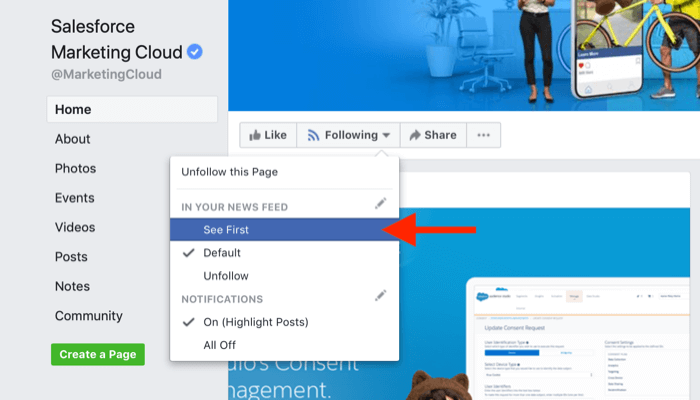
Remember, social media algorithms are looking for meaningful interactions between people, so ask internal influencers to leave long comments, tag their friends, and share your posts.

Pro Tip: Also ask employees to invite their online connections to follow your brand’s social accounts.
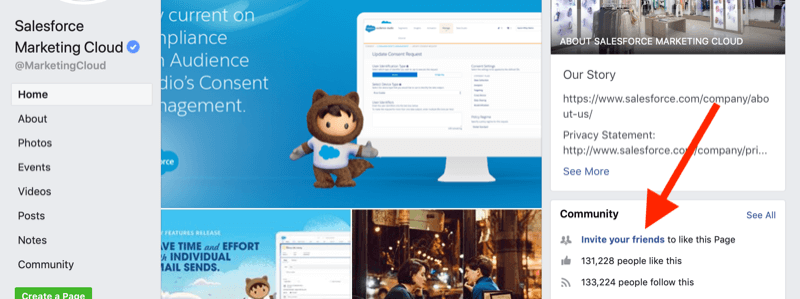
#2: Recruit and Identify Your Internal Influencers
To identify your internal influencers, first define your in-house network. Who is most invested in the success of your brand?
A large university’s network might include students, faculty, staff, and alumni. A mid-sized business might build a highly engaged group of employees and customers. An after-school program could engage a network of students, parents, and program donors. An entrepreneur just starting out might reach out to supportive family and friends.
Within this circle of brand advocates, you’ll find your internal influencers. These are people who have amassed a sizable audience on one platform or another and are willing to leverage their personal networks to promote your brand.
If you plan to evaluate your employee network to identify internal influencers, consider sending out a survey to determine who is interested in advocating for your brand and might have some clout.
SurveyMonkey is a popular survey creation tool. The free plan allows you to send a survey with up to 10 questions and view either 40 or 100 responses per survey (depending on when you created an account and your billing location).
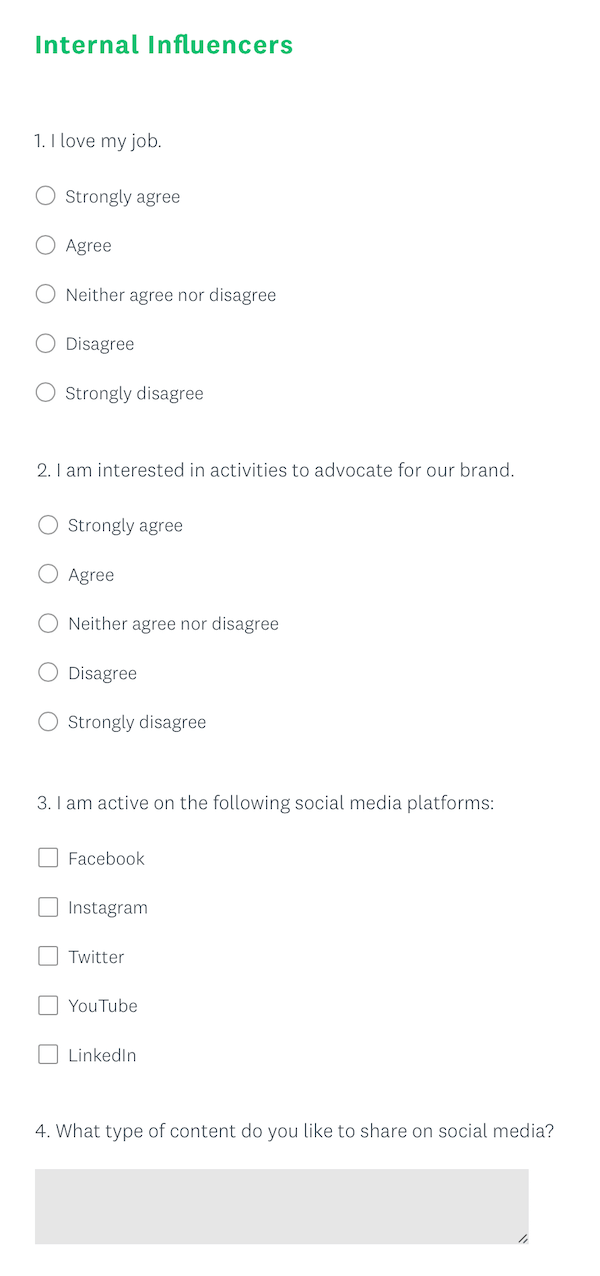
Conversations around the water cooler provide another opportunity to evaluate potential internal influencers. When you chat with employees, consider asking them questions like:
- Who do you turn to when you have a question about our business?
- Who among your coworkers is most enthusiastic about our business?
- Which employees are most active on social media?
Perhaps the most effective way to identify your internal influencers is to feature internal stakeholders on your social media channels. It’s always a good idea to celebrate your employees, assuming you have their permission and are mindful of privacy issues. Everyone has some degree of influence, so an employee spotlight campaign will yield results on its own.
But when you feature an influencer, you’ll see a noticeable spike in reach and engagement, especially shares. Monitor post analytics for positive performance trends associated with specific people. If you share a video spotlight of an employee on social media, check the video insights to see viewer demographics.
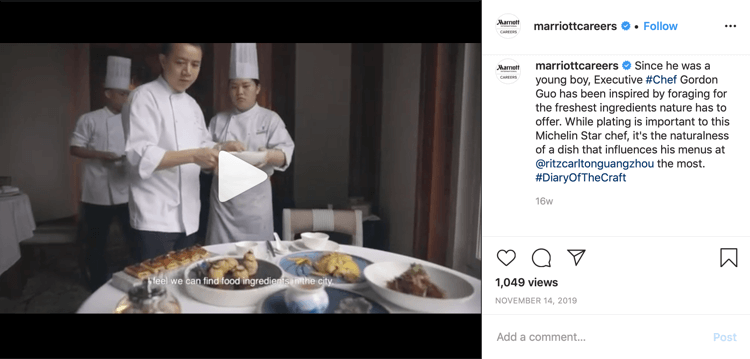
The featured employee’s influence may be apparent in a metric like viewer location. If the employee is from out of state, you’ll see an uptick in viewership from that region, which creates a powerful opportunity to extend your brand’s reach. In fact, a significant amount of the average employee’s social media audience is likely to be new to your brand.
For example, more than half of the views for this video from a California-based company came from Arizona. This is a testament to the power of internal influencers.
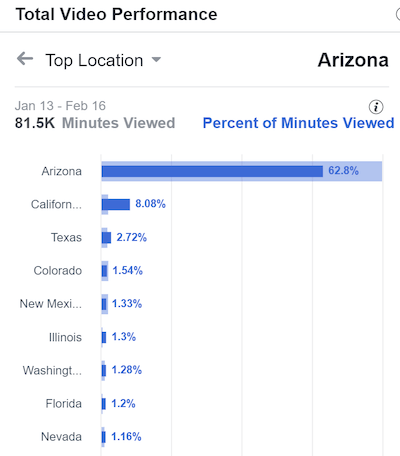
Once you’ve identified your internal influencers, it’s time to engage them. Here are some key ways to do that.
#3: Inform Internal Influencers About Company Updates and News
It’s always a best practice to keep internal stakeholders up to date on news about your business. Whatever your internal communications platform, you’re likely sharing major company announcements and big-picture accomplishments with your entire staff. Most employees will be happy to share company wins on their personal social media accounts.
Don’t be afraid to brag! Posting about your company’s accomplishments is a win-win for employees and employers alike. Internal influencers will be eager to share content that connects them with a successful brand.
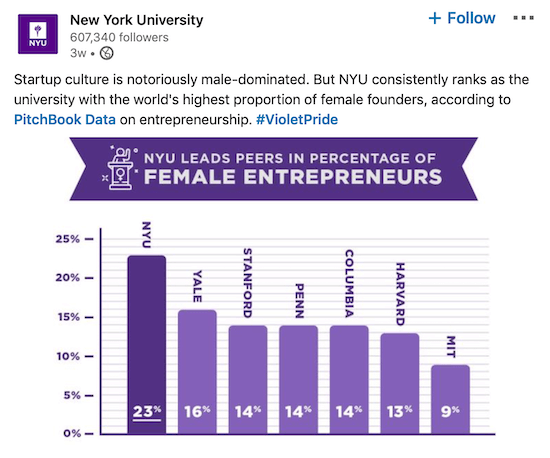
In addition to sharing major company announcements, keep your internal influencers informed of your social media strategy. Remember, they’re probably not marketing experts—and they don’t need to be. To inspire meaningful, sustainable engagement, help them understand the impact of their efforts. The conversation might go something like this:
“By liking one of our social media posts, you’re telling the platform’s algorithm that our content is valuable. Because you’re interested in the content, the algorithm decides that other people might like it, too. As our content gets more engagement, it becomes more valuable, and the algorithm will show it to more people, which helps us reach new audiences with our brand’s message.”
Pro Tip: Show your internal influencers that you value them by asking for their input on social media content and strategy. Many of your influencers will be active on social media and may have some creative ideas about how to engage an audience. Soliciting their feedback could certainly be to your brand’s benefit.
#4: Feature Internal Influencer Content on Your Social Media Channels
Engage your internal influencers by asking them for content to share. Often these influencers will be your brand’s boots on the ground, so they’ll have access to a wealth of photos and videos featuring your product or service, as well as other employees and customers.
Find opportunities to share their photos and highlight their accomplishments on your social channels. They’re most likely to engage with content that features them, which, in turn, will grab the attention of their friends and family.
PetSmart’s #LifeAtPetSmart campaign highlights one of the biggest draws of working for the company—the opportunity to bring your furry friends to the office. It’s engaging content that internal stakeholders and influencers are likely to share. Who wouldn’t retweet a picture of their pup?
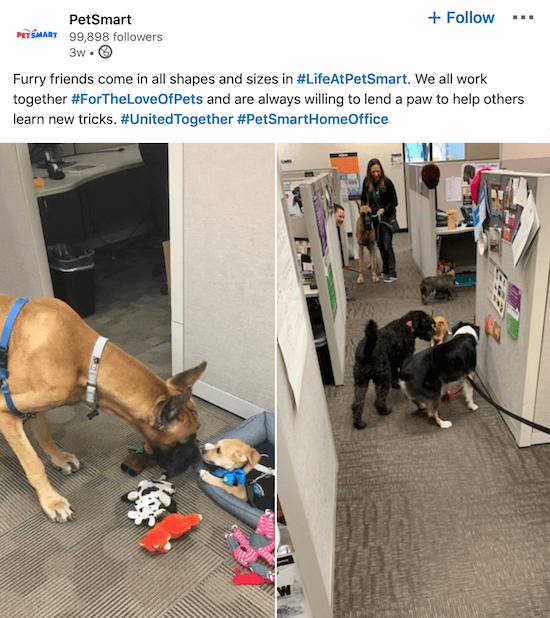
Social media takeovers are another popular way to engage internal stakeholders and humanize your brand.
For instance, many universities turn over the reins of their Instagram stories to student ambassadors for a day, giving prospective students an idea of what life is like at the school. The University of Victoria invites students to submit “visually interesting and easy to understand” Instagram Stories takeover ideas through the university’s website.
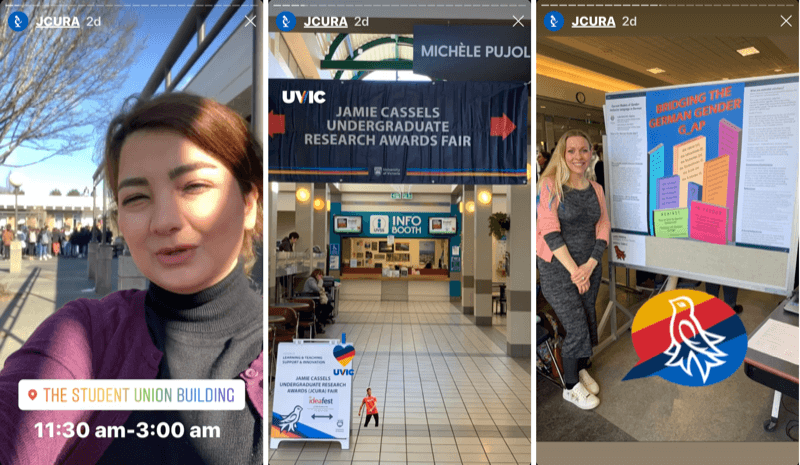
Get creative in who you feature, and give your audience a behind-the-scenes look at the people who champion your product or service. In addition to driving reach and engagement, stakeholder spotlights humanize your brand and build deeper connections with your fans.
The Arizona Game & Fish Department saw excellent results on social when they turned the camera around to spotlight the agency’s talented in-house photographer.

Pro Tip: Employee newsletters can also be an effective channel for celebrating your staff and creating shareable content about internal influencers. Many email marketing platforms work well for internal communications and provide links for readers to share newsletter content directly to social media.
A tool like Constant Contact lets you include a share bar at the top of your email so people can post a link to your newsletter content directly to their social pages. Pricing on the platform varies depending on the features you want and the size of your contact list, but it’s only $20 per month for a basic plan with fewer than 500 contacts.
Set Up a Content Submission Process
You’ll want to create an easy content submission process and encourage internal influencers to share photos, videos, and stories from their teams. Remind them that the social media algorithms love recognizable faces, and so do their friends and family. Photos that feature influencers’ faces will inspire engagement and maximize your brand’s reach.
If you use G Suite, you can create a simple content submission form in Google Forms. The platform is free for personal use and costs $6–$25 per user per month for business.
Here are some fields you might want to include in your form:
- Name, title, and department
- The post must be shared by what date?
- Who was involved in the activities described in the post?
- What date did the activities described in the post take place?
- Information to include in the post
- Attach photos or videos to accompany the post
- Links to include in the post
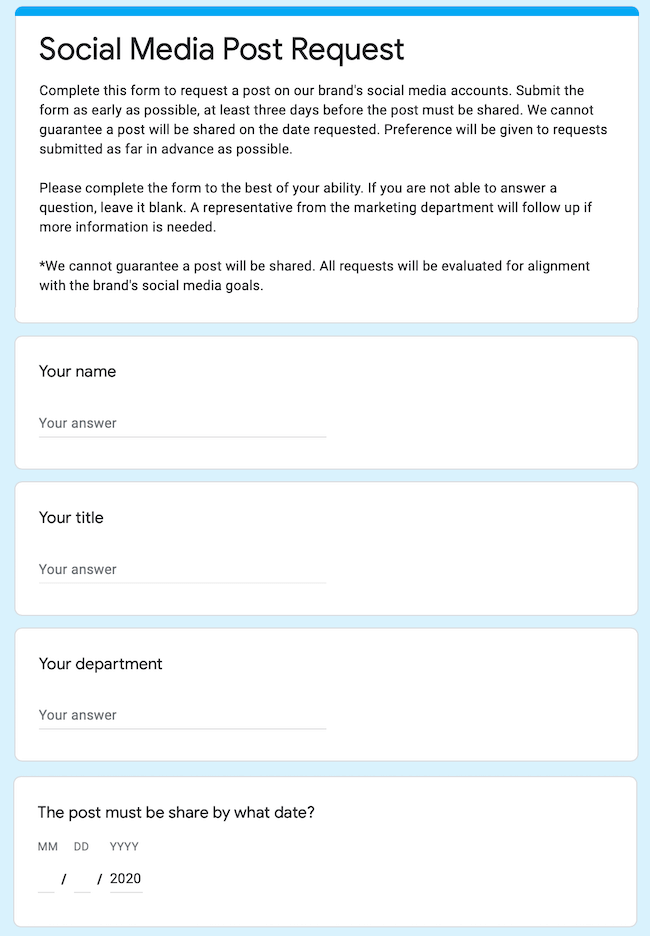
Once you’ve created a content submission process, encourage people to use it! You won’t get many post requests if no one knows about the form. Don’t stop at email, either. Find opportunities to get in front of teams within your business to promote the new process.
Do you use Facebook groups to engage your internal stakeholders? If so, you can leverage these communities to solicit content from your internal influencers. Inform members of upcoming campaigns and holidays you plan to recognize on social media, and provide them with opportunities to participate by submitting content.
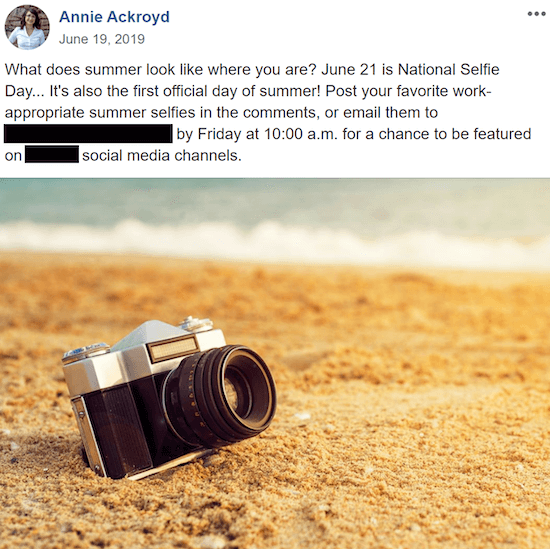
Follow Up With Internal Influencers
There’s not much benefit to featuring your internal influencers on social media if they don’t know that you did, and you can’t always rely on the algorithm to deliver your content to their news feeds. Once you’ve featured an influencer on your social media channels, tell them about it! Reach out personally and be direct.
Here’s a sample follow-up email:
“Thanks so much for participating in our social media campaign! I shared your photo and quote on our Facebook page. I encourage you to like and share the post. This will help us reach more people.”
Make sure to include a direct link to the post to make it easy for the influencer to access and share it. Most people will be flattered that you’re using your brand’s platform to put them in the spotlight and will happily engage with the post.
Once the post has been up for a few days, let them know how it performed. They’ll be more inclined to participate in the future if they believe they’re making an impact.
“Thanks again for participating in our social media campaign last week! I thought I’d let you know that your employee spotlight video reached about 23,000 people and received more than 1,500 engagements. According to the video insights, more than 70% of our viewers were from out of state, which means you helped us reach a new audience with our brand’s message.”
Conclusion
Internal influencers are some of your brand’s most valuable assets if you leverage them effectively. They are enthusiastic about your brand and willing to engage their personal networks to amplify your message.
When internal stakeholders are sincere in their enthusiasm for your product or service, your audience is more likely to trust them. Use the tips in this article to find and engage them, and watch your reach and engagement grow.
What do you think? Will you enlist employee influencers to extend your brand’s reach? Share your thoughts in the comments below.




